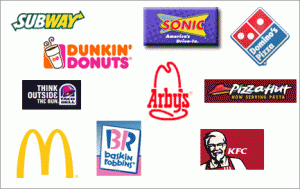the brand promise:reality gap
Attention: fast food marketers – you’re wasting half of your advertising!
But I’m not talking about the waste that John Wanamaker was referring to in his famous quip about not knowing which half of his advertising was being wasted. I’m talking about the average of 48% of people who say there’s a big difference between what you promise in your advertising and what they experience at your restaurants.
This gap between your brand promise and your brand reality is one of the findings from research I recently conducted on QSRs*.
It’s no surprise that the everyday fast food experience doesn’t measure up to the fresh food, friendly service, and fun environment depicted in category advertising — but a disconnect of this degree is disturbing. Even more troubling is that up to 66% of customers report a gap between the brand promise and brand reality for some chains!
I’ll keep the names of the worst offenders confidential, but I will reveal that the list includes a company which recently undertook a “rebranding” effort (i.e., new logo and visual identity) and another which recently announced plans to roll-out a value promotion. While these changes might have been important, I can’t help but wonder if the effectiveness of these efforts will be limited because their in-restaurant experience isn’t delivering on the brand promise.
The findings from my research have serious implications for marketers in the fast food category and beyond. Given that 64% of CMOs and brand managers at a wide range of organizations say their brands do not influence decisions made at their companies (see a previous post of mine on this shocking finding), it’s likely there’s a disconnect between the brand aspirations and operational reality at most companies.
The brand promise:reality gap suggests that instead of fretting over brand campaigns, companies’ brand-building efforts might be more successful if they were directed toward the actual customer experience.
Sure, the company’s ops department is responsible for ensuring operational excellence in the customer experience – but for most chains, competitive advantage is largely dependent upon the values and attributes which differentiate the brand. So, operations must be about more than delivering efficiency and quality. Aligning the customer experience with the brand vision is critical to establishing and sustaining a strong brand.
Furthermore actions speak louder than words and the research findings make it clear companies need help putting brand values and attributes into action.
One way to do this is to use a brand toolbox to inspire, inform, and instruct everyone in your organization how to interpret and reinforce your brand.
A brand toolbox is a collection of tools such as:
- a brand strategy users’ manual which explains the brand essence and positioning and the rationale behind them
- principles and guidelines for delivering brand values and attributes in day-to-day situations
- decision guides and process outlines to facilitate on-brand decision-making and behaviors
- virtual reality platforms which enable employees to practice using brand principles to deliver customer experiences consistent with the brand promise
- a forum through which employees can share their insights about how to bring the brand to life
Importantly a brand toolbox isn’t some yay-rah-rah feel good “invertising” effort which simply promotes the brand to employees. Nor is it a dense training manual which collects dust on a shelf. It’s a dynamic resource integrated into the company’s standard operating procedures.
It requires active engagement and consistent updating – and an investment of time and money. Come to think of it, developing and managing a brand toolbox is similar to developing and managing a brand campaign. But instead of simply promoting an image, it helps translate that image into remarkable customer experiences.
In today’s resource-constrained environment, a company cannot afford to spend its precious marketing dollars on a brand campaign only to see them wasted when the customer walks through the door. Closing the brand vision:promise gap needs to be a top priority.
p.s. A brand toolbox is only one of several ways to close the brand vision:promise gap. Please contact me to learn about others: mail AT deniseleeyohn DOT com.
* survey was fielded among over 200 moms with kids
related posts:
